
|

|
|
Project Summary: HIP's Artists' Housing
OWNER/DEVELOPER
Housing Initiative Partnership, Inc.
ARCHITECT
Wiencek + Associates Architects + Planners, PC
LANDSCAPE ARCHITECT
Tetra Tech, Inc.
CONTRACTORS
Hamel Builders Inc.
PROPERTY MANAGEMENT
Housing Initiative Partnership, Inc.
|
FUNDERS:
|
TYPE:
|
|
MD Dept of Housing and Community Dev.
|
Loan |
|
Prince George's County Dept. Of Housing and Community Dev.
|
HOME Funds Loan
|
| State of MD |
Grant |
| MD Department of the Environment |
Grant |
| PEPCO |
Grant |
| FHLB of Atlanta through Riggs Bank |
Grant |
| Redevelopment Authority of Prince George's County |
Grant |
| Philip L. Graham Fund |
Grant |
| Prince George's Community Foundation |
Grant |
|
Prince George's County Dept. of Environmental Resources |
Installed bio- retention pond |
DEVELOPMENT TYPE:
Rental apartments
RESIDENT PROFILE:
50% State-wide median income or less.
DENSITY: 87 units per acre
DEVELOPMENT PROFILE
| Type |
#/Units |
Size (sf) |
Rent |
| 1 BR |
12 |
574 - 673 |
$475 + utilities |
| Total |
12
|
|
|
Laundry:Laundry closet on 2nd and 3rd flr. Accessible unit of first floor has laundry within
the apartment.
Courtyard/play: Rooftop deck
Parking: On-street
Total site area:
5,987sf (.14 acres) |
CONSTRUCTION TYPE
Gut renovation of brick building w/existing wood frame floors and roof.
Studio extensions are concrete slab floors.
DEVELOPMENT COSTS:
Land cost: $245,000 (including exist. bldg); Constr. costs:
$1,100,000; Other costs: $484,716; Total
development costs: $1,829,716 ($152,476/unit);
Completed July 2003. |
|
|
HIP's Artists' Housing- Mount Rainier, MD
Green Features
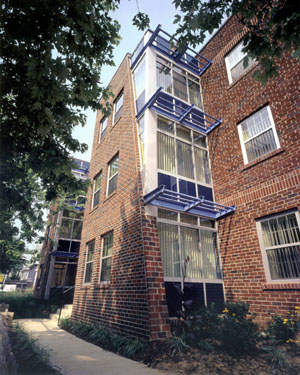
This Mount Rainier, Maryland project is the first artists’ housing development in the Gateway Arts
District of Prince George’s County, MD. Developed by Housing Initiative Partnership, Inc., HIP, the
project provides housing opportunities for low- and moderate- income residents. HIP's Artists’ housing
inhabits a formerly blighted building, helping to transform a neglected inner beltway community, and improve
the quality of life in the neighborhood. Under the State of Maryland’s Hot Spots program, the City of
Mount Rainier successfully targeted this building as a community nuisance. It was overcrowded with poorly
screened tenants, and infested with rats, cockroaches, pigeons, and feral cats. Condemned for health reasons,
tenants were vacated and the building boarded up. During the foreclosure process, HIP negotiated the purchase
of the building and sought to convert it into a community beacon that would provide affordable housing for the
burgeoning Arts District. The result is an affordable residence that incorporates numerous green building design
features and provides vibrant studio spaces for the resident artists.
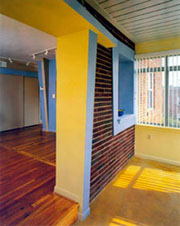 All design decisions for HIP's Artists' Housing were driven by three goals: creating daylit artists studios;
building environmentally responsible dwellings; and being sensitive to the building’s location within the
Mount Rainer Historic District. The project presented significant design challenges because of the building’s
tight urban lot, small existing apartments, and lack of common space. The new design honors the building’s
architectural character while reinvigorating it with studio additions that add a new twist. These studios
“push” sections of the historic brick wall away from the building while glass and steel membranes
infill the space between the brick walls, admitting light and views. The diagonal-versus-grid geometry of the
studios read through their front elevations, dynamically addressing the street corner.
All design decisions for HIP's Artists' Housing were driven by three goals: creating daylit artists studios;
building environmentally responsible dwellings; and being sensitive to the building’s location within the
Mount Rainer Historic District. The project presented significant design challenges because of the building’s
tight urban lot, small existing apartments, and lack of common space. The new design honors the building’s
architectural character while reinvigorating it with studio additions that add a new twist. These studios
“push” sections of the historic brick wall away from the building while glass and steel membranes
infill the space between the brick walls, admitting light and views. The diagonal-versus-grid geometry of the
studios read through their front elevations, dynamically addressing the street corner.
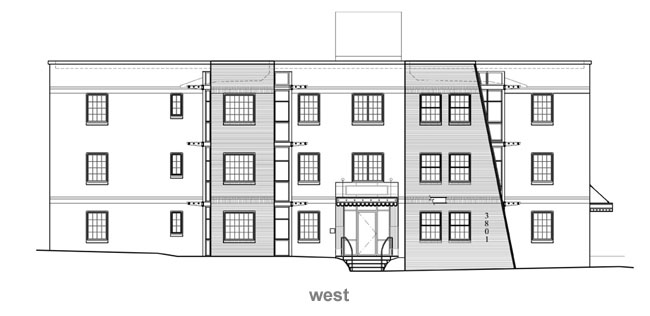
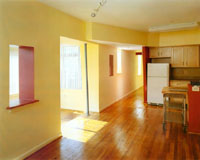 Tremendous attention was given to every detail of the interior spaces. All the apartments are colorful and lively
in plan and section. Walls are angled and sloped giving the resident interesting views from various vantage points
in their apartments. Kitchens were moved from their original locations near the apartment entry further into the
floor plan. This creates an open feeling in the living area and allows daylight from the studios to stream through
the entire apartment. The bedrooms are separated by rolling doors that can be left completely open in keeping with
the flowing feel of the floor plan. The architect was mindful of accommodating the artists’ spatial needs, in
addition to the daylit studios, generous built in storage cabinets and a work sink are also provided.
Tremendous attention was given to every detail of the interior spaces. All the apartments are colorful and lively
in plan and section. Walls are angled and sloped giving the resident interesting views from various vantage points
in their apartments. Kitchens were moved from their original locations near the apartment entry further into the
floor plan. This creates an open feeling in the living area and allows daylight from the studios to stream through
the entire apartment. The bedrooms are separated by rolling doors that can be left completely open in keeping with
the flowing feel of the floor plan. The architect was mindful of accommodating the artists’ spatial needs, in
addition to the daylit studios, generous built in storage cabinets and a work sink are also provided.

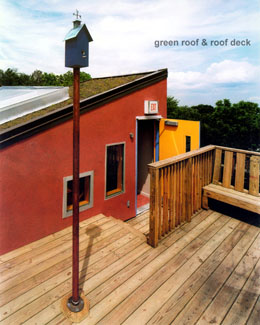 Access to the building’s green
roof was provided by the addition of a new flight of stairs. The spacious green roof deck provides for a common gathering
space in a building that could not accommodate one otherwise. The green roof has been planted with sedums that will flower
seasonally. Two birdhouses, one in the front of the building and one on the roof deck give a sense of whimsy and emphasize
the environmentally friendly design of the building. Views from windows facing the rear of the building have added interest
from two wind sculptures and a rock garden featuring playful bright blue and purple ceramic balls. The site’s open
space to the front of the buildings is enhanced with landscaping and walkways. Because of site constraints, parking is on
the street. Access to the building’s green
roof was provided by the addition of a new flight of stairs. The spacious green roof deck provides for a common gathering
space in a building that could not accommodate one otherwise. The green roof has been planted with sedums that will flower
seasonally. Two birdhouses, one in the front of the building and one on the roof deck give a sense of whimsy and emphasize
the environmentally friendly design of the building. Views from windows facing the rear of the building have added interest
from two wind sculptures and a rock garden featuring playful bright blue and purple ceramic balls. The site’s open
space to the front of the buildings is enhanced with landscaping and walkways. Because of site constraints, parking is on
the street.
Lessons Learned from the architect -
- We wanted to use geothermal heat pumps for the building, but our site was too tight for the
well drilling trucks to have adequate access. As a result we had to go with high efficiency conventional heat pumps.
- The bioretention pond on our site is a demonstration project of the County DEP. Bioretention ponds are often objected
to because they will attract mosquitoes. We’ve had no problem with that here, so in that regard it is a successful
demonstration of a bioretention pond in a dense area. We actually weren’t required to do anything specifically for
stormwater management since our project is in an existing building. If this had been a new building, this size bioretention
pond would not have been adequate, and we’d have had to resort to a more traditional structured system.
- We selected a light weight green roof system that uses a thin soil substrate so that the existing roof framing would
not have to be augmented. In the end, our contractor wanted to use a heavier system, so he sistered the roof joists to
accommodate the increase in load. Either way, the weight concerns of the green roof system are surmountable even on an aging
wood-frame structure
- The tankless water heaters have been an issue. The contractor substituted a different model than we specified and there
have been a lot of break downs and difficulty getting replacement parts.
- There wasn’t any additional subsidy for us to make this project green. It really came down to us, the architects,
and the contractor doing more than usual without additional compensation in order to achieve the level of green we wanted.
Juries Comments:
- Changes to the box were simple and elegant.
- The project has a unique floor plan relating to small spaces… here, small is beautiful
- They did a nice job extending the existing building and offer a compelling sidewalk view.
|

 All design decisions for HIP's Artists' Housing were driven by three goals: creating daylit artists studios;
building environmentally responsible dwellings; and being sensitive to the building’s location within the
Mount Rainer Historic District. The project presented significant design challenges because of the building’s
tight urban lot, small existing apartments, and lack of common space. The new design honors the building’s
architectural character while reinvigorating it with studio additions that add a new twist. These studios
“push” sections of the historic brick wall away from the building while glass and steel membranes
infill the space between the brick walls, admitting light and views. The diagonal-versus-grid geometry of the
studios read through their front elevations, dynamically addressing the street corner.
All design decisions for HIP's Artists' Housing were driven by three goals: creating daylit artists studios;
building environmentally responsible dwellings; and being sensitive to the building’s location within the
Mount Rainer Historic District. The project presented significant design challenges because of the building’s
tight urban lot, small existing apartments, and lack of common space. The new design honors the building’s
architectural character while reinvigorating it with studio additions that add a new twist. These studios
“push” sections of the historic brick wall away from the building while glass and steel membranes
infill the space between the brick walls, admitting light and views. The diagonal-versus-grid geometry of the
studios read through their front elevations, dynamically addressing the street corner.

 Tremendous attention was given to every detail of the interior spaces. All the apartments are colorful and lively
in plan and section. Walls are angled and sloped giving the resident interesting views from various vantage points
in their apartments. Kitchens were moved from their original locations near the apartment entry further into the
floor plan. This creates an open feeling in the living area and allows daylight from the studios to stream through
the entire apartment. The bedrooms are separated by rolling doors that can be left completely open in keeping with
the flowing feel of the floor plan. The architect was mindful of accommodating the artists’ spatial needs, in
addition to the daylit studios, generous built in storage cabinets and a work sink are also provided.
Tremendous attention was given to every detail of the interior spaces. All the apartments are colorful and lively
in plan and section. Walls are angled and sloped giving the resident interesting views from various vantage points
in their apartments. Kitchens were moved from their original locations near the apartment entry further into the
floor plan. This creates an open feeling in the living area and allows daylight from the studios to stream through
the entire apartment. The bedrooms are separated by rolling doors that can be left completely open in keeping with
the flowing feel of the floor plan. The architect was mindful of accommodating the artists’ spatial needs, in
addition to the daylit studios, generous built in storage cabinets and a work sink are also provided. 
 Access to the building’s green
roof was provided by the addition of a new flight of stairs. The spacious green roof deck provides for a common gathering
space in a building that could not accommodate one otherwise. The green roof has been planted with sedums that will flower
seasonally. Two birdhouses, one in the front of the building and one on the roof deck give a sense of whimsy and emphasize
the environmentally friendly design of the building. Views from windows facing the rear of the building have added interest
from two wind sculptures and a rock garden featuring playful bright blue and purple ceramic balls. The site’s open
space to the front of the buildings is enhanced with landscaping and walkways. Because of site constraints, parking is on
the street.
Access to the building’s green
roof was provided by the addition of a new flight of stairs. The spacious green roof deck provides for a common gathering
space in a building that could not accommodate one otherwise. The green roof has been planted with sedums that will flower
seasonally. Two birdhouses, one in the front of the building and one on the roof deck give a sense of whimsy and emphasize
the environmentally friendly design of the building. Views from windows facing the rear of the building have added interest
from two wind sculptures and a rock garden featuring playful bright blue and purple ceramic balls. The site’s open
space to the front of the buildings is enhanced with landscaping and walkways. Because of site constraints, parking is on
the street.